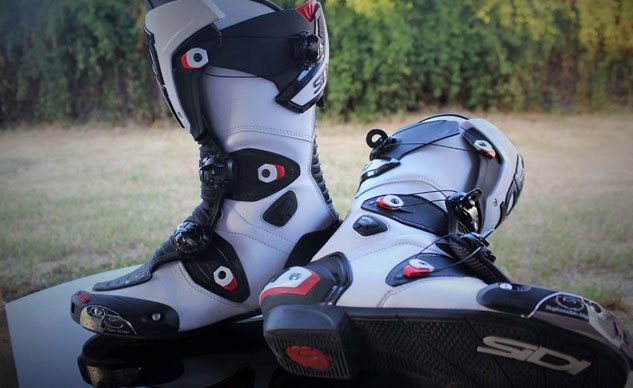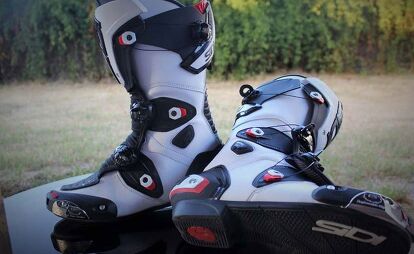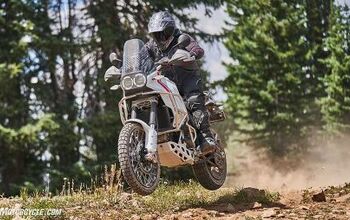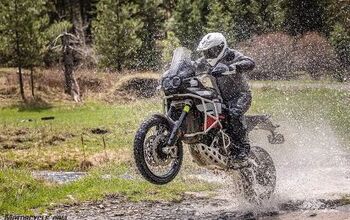Sidi Mag-1 Boot Review
Top-shelf protection married with newfangled convenience
A motocross-related foot/ankle injury once kept me in non-weight-bearing medical status for six incredibly painful months. Twelve years of recovery and therapy later, the range of motion in my right ankle remains at only about 15%, and lingering pain is a regular reminder of my injury. Considering this history, it should be no surprise that I highly value foot protection.
Sidi Mag-1 Boot
| Aesthetics | 9.5/10 |
| Protection | 9.0/10 |
| Value | 7.0/10 |
| Comfort/Fit | 9.0/10 |
| Quality/Design | 9.5/10 |
| Weight | 9.5/10 |
| Options/Selection | 7.0/10 |
| Innovation | 9.0/10 |
| Weather Suitability | 9.0/10 |
| Desirable/Cool Factor | 9.5/10 |
| Overall Score | 88/100 |
Sidi has a long history of building quality motorcycle footwear, the Italian company consistently updating its lineup of boots over decades. The Vortice, introduced a few years ago, became my first choice of protective footwear for riding on a racetrack. I valued the snug fit made available by Sidi’s Tecno system of four nylon monofilament lines that tighten via a hand-turnable ratcheting mechanism. With slack taken up from the lines, the Vortices feel like a custom-fitted boot. In terms of fit and protection, they were nearly unbeatable. However, the Vortices’ collection of flaps, slots, tuners (and a zipper) made these the last pair of boots to choose if you were ever surprised by a “last call to the grid” message over a track’s PA. They are frustratingly finicky to don in a hurry.
But Sidi’s new Mag-1 boot takes lessons learned from the Vortice and transforms it from fussy to pleasingly effective. The Vortices’ plethora of flaps, tabs and zipper have been reduced to just three simple closures using the new Micrometric Tecno-3 magnetic closure mechanism. It uses small magnets to bring the closure tabs in the proper position in their slots, leaving a rider to simply dial up the amount of desired tension in the three coated stainless steel threads via the tunable ratcheting system.
The difference in booting-up times is astounding. Properly and completely strapping on a Vortice requires nearly one full minute – an eternity if you’re in a hurry, and don’t forget you have two feet to strap in. The Mag-1s require only about 10 seconds each, and removing one takes less than five seconds.
Hmmm, you might think, magnets are heavy, aren’t they? Apparently not so much, as Sidi claims the Mag-1s are 17% lighter than the Vortices because of the vast reduction in tabs and slots and also the removal of the zipper and the pivoting mechanism of the Vortice’s external frame. Nevertheless, the protective elements of the Mag-1s appear robust.
The internal support system is a frame of carbon fiber beams that resist side-to-side movement while not unduly restricting adequate fore/aft movement. The heel area is protected by an armored cup consisting of thermoplastic polyurethane (TPU) and a rubber shock-absorbing layer. The arch and achilles areas are supported by two elastic TPU bands bridging the Tecno-3 magnetic closures, and a rigid TPU panel in the calf area ties it all together with the boots’ third closure.
The boot itself is made of a synthetic leather Sidi dubs Technomicro, which is purported to be lighter, softer and stronger than cow leather. It’s also water-resistant and easier to clean. All high-stress areas are double stitched. A cozy material called Cambrelle lines the toe box, while the rest of the interior uses a perforated Teflon-treated nylon that breathes exceptionally well.
Donning the Mag-1s is a pleasure, especially when compared to the Vortice’s puzzle of flaps and connections. The Tecno-3 adjustment system is able to snug the boot as tight as you like. The Mag-1s don’t quite achieve the hand-in-glove, custom-fitment feeling of the Vortice, but that’s a bar set exceedingly high.
The only comfort issue I have with the Mags is a toe box that is a little short, top to bottom, for the big toe on my left foot. As always, your mileage may vary, depending on the shape of your feet. Sidi offers a wide range of sizes, from 3-3.5 to size 15. The Mag-1s also incorporate an adjustable “micrometric” strap in the calf area that, with the Tecno-3 adjuster, can accommodate a gargantuan gam 15 inches in diameter.
The bike side of the CE-approved boot has far fewer protuberances than the Vortice, which, depending on a particular motorcycle, could sometimes get partially snagged by a footpeg bracket or frame rail. The Mag-1s allow hooves to snug up close to a bike, providing superior feedback through the feet. A relatively thin sole also helps transmit bike responses.
When laying out almost $500 for boots, it’s nice to know that almost every component is replaceable so they can be kept in top shape even after a lot of use and abuse. All screws that attach the various technical parts are recessed so they don’t contact and mar the bike.
Conclusion
The Mag-1s are a valuable addition to my riding wardrobe. They look terrific, seem to be very protective, and their trick closure system allows a customized fit. They also do a great job at dispersing heat, especially with the toe vents in their open position, which keeps feet happy even in hot conditions. And, when not on a racetrack, the slim calf area allows them to fit under riding jeans.
Sure, the Mag-1s aren’t cheap, but the best stuff never is. And if you’ve ever suffered a foot injury, spending $500 on top-shelf protection will seem to be a wise investment.
More by Kevin Duke














































Comments
Join the conversation